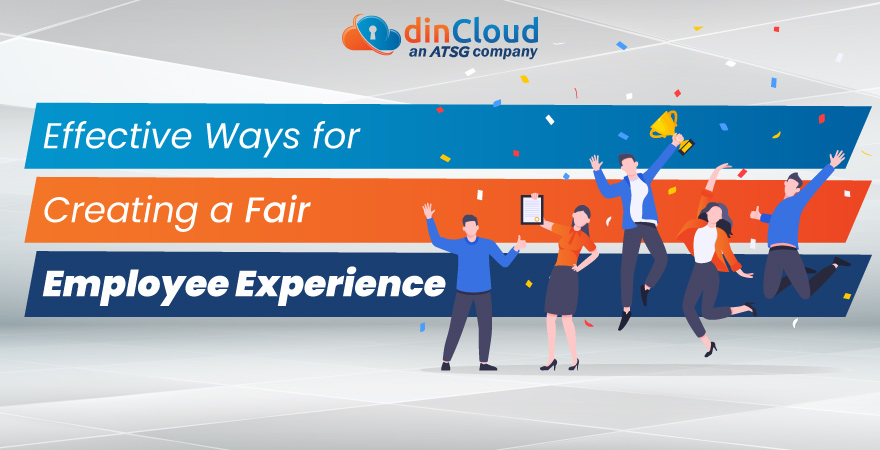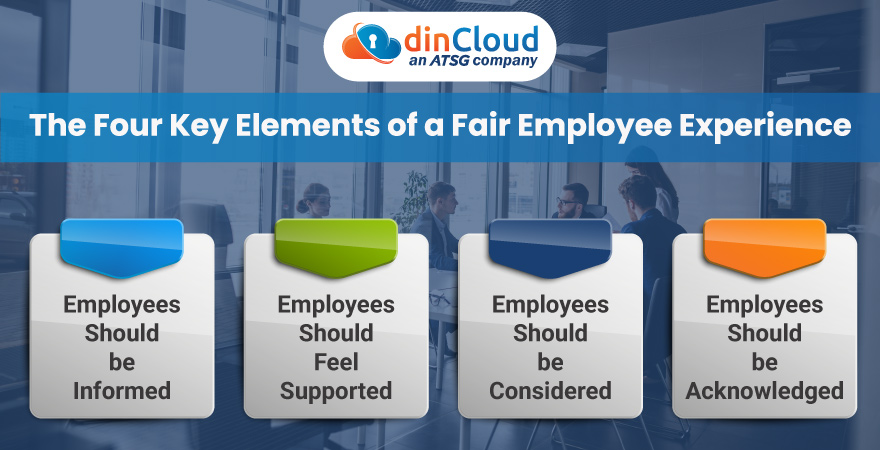Majority of the organizations want to achieve “best-in-class” company status and understandably so. However, the ongoing competition for attention and resources makes it a difficult, albeit achievable task. A tried and tested way to help enterprises stand out and attract top talent is by creating a fair employee experience (EX) across their workforce.
It is important because numerous “micro-moments” create a holistic experience, which lays a strong foundation for creativity, innovation, and increased employee engagement. All this will ultimately motivate employees to elevate your enterprise’s productivity, and take it to a whole new level.

The Surging Value of a Fair Employee Experience
The following statistics support the fact that an increasing number of enterprises are now working towards providing a fair employee experience.
- Almost 90% of Fortune 100 companies see equity as a key part of their corporate values.
- Since the year 2018, there has been a phenomenal 658% increase in the mentions of Diversity, Equity, and Inclusion (DEI) on Standard and Poor’s 500 earnings calls.
- Not just that, numerous enterprises have even introduced an emerging executive position of the Chief Purpose Officer, to deal with the buzz-generating trends related to society, politics, and culture.
Even though all the aforementioned statistics show a promising picture, there is a growing divide between enterprises and their employees.
Gartner conducted a survey of 3,500 employees regarding fair employee experience, from across the globe. Unfortunately, only 18% of the surveyed employees felt that their working environments were fair, based on how enterprises manage employee pay, promotions, and talent.
This is a bad indicator not only for the enterprise’s Human Resource (HR) departments but also for top executives. The reason for this is that everything from enterprise resource allocation and internal/external communications to risk management and technology utilization is impacted by fairness. Research suggests that fairness results in a 26% increase in employee productivity and a 27% increase in retention levels.
A large number of enterprises are now developing progressive and inclusive policies about recruitment and remuneration, as well. The purpose is to mitigate any bias, inequity, and unfair advantage during promotions, pay raises, and various other significant junctures of the employee life cycle.
Related Posts
- Digital Employee Experience (DEX) – The New Business Imperative!
- What is Digital Employee Experience (DEX) and Why It’s Important?
- Why is Digital Employee Experience (DEX) Vital for Enterprise IT?
How to Achieve a Truly Fair Experience?
Developing DEI initiatives for underrepresented employees alone is not enough. Enterprises must create a “level playing field” for everyone. Donald Fan is the Senior Director of the global office of culture, diversity, and equity at Walmart. He is of the opinion that the goal is to give everyone, including women, people of color, and white male associates the same resources, access to tools/technologies, and inclusion in decision-making policies.
The fan further suggested that enterprises should develop talent strategies to manage the diverse workforce, having unique circumstances and experiences. For that, enterprises should not only focus on policies but also on philosophies around those policies.
The Four Key Elements of a Fair Employee Experience
It is important for organizations to check the level of fairness in their work environments. For this, top executives and key decision makers should definitely consider the following mentioned approaches, which can also improve their Digital Employee Experience (DEX).

1. Employees Should be Informed
The fast-paced internet and smartphones have made everyone’s life easier. We can easily search for things, and instantly get informed about stuff. Why is it that there is no easy way for employees to find out about the ways to get promoted or alter their career path? Research conducted by “The Org” suggested that 70% of the surveyed employees preferred switching to another organization that had higher transparency levels regarding career progression.
It has also been reported that enterprises usually practice 33% of transparency. HR teams usually have a good reason for it too, as they do not want to share confidential and sensitive data without any formal guidelines about how to use it.
From the employee’s perspective, however, a lot of misinformation and in-equity regarding recruiting processes and pay scales usually exacerbate their suspicion and resentment, adding “fuel to the fire”.
The good news, a lot of these trends are changing now. For instance, Procter and Gamble (P&G) have started publishing its interview questions online. Similarly, Gitlab has started publishing its employee handbook online, so that employees can upvote or downvote specific policies.
When it comes to transparency, the following two points are very important.
- The same information should be available for every employee in a balanced way.
- There should be guidance to help employees regarding the actionability and usefulness of this information.
2. Employees Should Feel Supported
During the Covid-19 pandemic, the global workforce felt burnout, fatigue, and anxiety at unprecedented levels. To tackle this problem, around 64% of enterprises introduced well-being benefits. Even with all these initiatives, only 32% of employees reported feeling supported at work.
Interestingly, there is a striking difference between the perception of employees without children (27% feel supported) and working parents (37% feel supported). This sparked a debate about organizations going out of their way to support working parents. Employees without children felt that they had to pick up the slack, and perceived it to be unfair to them.
Then, there is a physical dimension of the perceptions of in-house employees, and those working from home (WFH). Employees working from the office envy those with flexible working environments. The resentment is understandable, as 45% of the employees with flexible jobs stated that it was better for their mental state, as compared to 26% of workers, with no flexibility in their work schedules.
Furthermore, it has been seen that employee experience is more about shaping the perception of experience (64%), and less about the actual steps that enterprises take to improve it.
Organizations can improve employee perception by adopting the following strategies:
- Firstly, you should explicitly inform your employees about the reasons why HR is supporting certain employees more and how, from a broader perspective, everyone can benefit through these employee support programs.
- Even though the initial incentive behind the benefits might be directed towards a specific workforce stratum, the final support design should be universal.
- Lastly, organizations should acknowledge that every employee has unique struggles and they should shape a comparison about how every employee needs different benefits.
3. Employees Should be Considered
More than one in two employees state that they feel a high level of fairness when their enterprises consider them for opportunities they are capable of pursuing. Organizations usually follow either of these two paths to expand opportunities.
- Assigning managers the task to consider employees for growth opportunities. This puts managers under immense pressure, and they end up promoting people who they know are capable enough to perform the task.
- Asking employees to advance their own profile. Again, this puts a lot of pressure on employees.
In such circumstances, enterprises must try to strike a balance, and inculcate innovative talent strategies. Here, employees can support their peers with coaching and peer-to-peer development. Enterprises can also leverage employee referrals for internal talent opportunities.
Organizations should also take the following mentioned steps to encourage an effective and fair internal referral program.
- Set expectations with the workforce about their fair recommendations regarding emerging opportunities.
- Create such mechanisms that enable employees to know the workflow of the entire organization. This will help them recommend qualified people.
- Effectively monitor the situation to produce the desired results.
4. Employees Should be Acknowledged
The majority of the time, employees need validation that their contributions do not go unnoticed. According to a Gartner report (2021), only 24% of the surveyed employees said that they felt acknowledged by their organizations. Additionally, the rise of hybrid-working environments has further grown the gulf between remote-based workers and their managers.
There was another survey by Gartner in May 2020, where remote-based employees said that their performance was just as good as those working in an office. Despite this, some 72% of managers admitted that on-site workers are more likely to be promoted, probably due to better visibility.
HR personnel and key decision-makers can overcome this challenge by spotlighting every employee’s contribution, regardless of the status as an in-house, or remote-based resource. They can incorporate the inputs of managers, peers, and technologies to paint an accurate picture of everyone’s contributions.
Conclusion
There are no “universal guidelines” that exist precisely for your enterprise’s specific needs. However, fair employee experience initiatives and transparent workplace shifts can help you stand out and set you apart from your competitors. This way, your workforce will feel informed, supported, considered, and acknowledged.
Contact dinCloud, an ATSG company, for flexible and secure Cloud Computing solutions that will definitely improve the Digital Employee Experience (DEX) for your enterprise.


